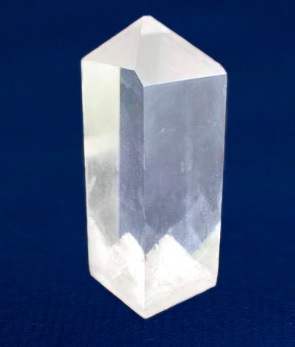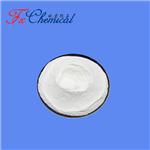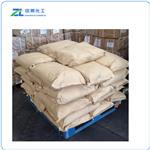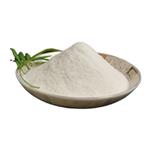description
Ammonium dihydrogen phosphate (ADP) is a transparent, piezoelectric crystal containing no water of crystallization. Single crystals of this material were originally developed for use in underwater sound projectors and hydrophones.

Transducer problems during World War II fostered a joint study program on this material by Bell Telephone Laboratories, Brush Development Company and the Naval Research Laboratories. An adequate and relatively simple technology was developed in this joint effect to grow ADP crystals and to fabricate them into sonar transducers. ADP is comparable to ordinary table salt in workability, brittleness and solubility. Blumenthal was one of the first investigators to demonstrate the successful microwave modulation of light by using the electrooptic effect in ADP.
Chemical properties
Ammonium dihydrogen phosphate is a colorless transparent tetragonal crystal. soluble in water, slightly soluble in alcohol, insoluble in acetone.
Ammonium dihydrogen phosphate or monoammonium phosphate is formed when a solution of phosphoric acid is added to ammonia until the solution is distinctly acid. It crystallizes in quadratic prisms. Monoammonium phosphate is often used in the blending of dry agricultural fertilizers. It supplies soil with the elements nitrogen and phosphorus in a form which is usable by plants. The compound is also a component of the ABC powder in some dry powder fire extinguishers.
Uses
- Monoammonium phosphate (MAP) is a widely used source of P and N. It is made of two constituents common in the fertilizer industry and has the highest P content of any common solid fertilizer.
- MAP has been an important granular fertilizer for many years. It is water soluble and dissolves rapidly in soil if adequate moisture is present. Upon dissolution, the two basic components of the fertilizer separate again to release NH4 + and H2PO4 - . Both of these nutrients are important to sustain healthy plant growth. The pH of the solution surrounding the granule is moderately acidic, making MAP an especially desirable fertilizer in neutral and high pH soils. Agronomic studies show that there is no significant difference in P nutrition from various commercial P fertilizers under most conditions.
- Leavening agent, dough regulator, yeast food, brewing fermentation additives and buffer in the food industry.
- Animal feed additives.
- Nitrogen and phosphorus compound fertilizer with highly efficient.
- Fire retardant for wood, paper, fabric, dispersant for fiber processing and dyeing industry, glaze for enamel, cooperating agent for fire retardant coating, decontamination agent for match stalk and candle core.
- In indurstis of printing plate and pharmaceutical manufacturing.
Content analysis
Accurately weighed about 500mg sample, dissolved in 50ml of water, with 0.1mol/L sodium hydroxide titration to pH 8.0. per mL, 0.1mol/L sodium hydroxide is equivalent to diammonium phosphate [NH4H2PO4] 11.50 mg.
Toxicity
ADI: 0 to 70 mg/kg (amount of total phosphate as phosphorus; FAO/WHO, 2001).
GRAS (FDA, § 184.1141a, 2000).
Preparation method
Venturi loop reaction method: 85% thermal phosphoric acid will be diluted 1.3 to 1.4 times, after the measurement into the venturi tube flow mixing reactor, where it is sufficiently homogeneously mixed and reacted with the incoming ammonia gas, and the reaction process is continued in the pipeline. Finally the qualified liquid enters into the cycle reaction tank, adjusting the Ph value between the range 4.4 to 4.6, filtering and cooling the filtrate down to 26 oC, obtaining the crystal solid, separating and dehydrating, and then drying it to obtain the dihydrogen phosphate Ammonium products.
H3PO4 + NH3 → NH4H2PO4
Neutralization method: firstly dilute the phosphoric acid to get a solution with 50% to 55% concentration, and then take some measured solution into an enamel reaction tank with stirring and jacket. In stirring, the ammonia gas is slowly added into the ammonia tube distributor for neutralization. Waiting till the Ph value of the neutralized solution gets between 4.2~4.6, filter it immediately and send it into the cooling crystallization mold, then obtain crystallization when the temperature gets down to 26 °. Dry after dehydration and then obtain ammonium dihydrogen phosphate products.
H3PO4 + NH3 → NH4H2PO4
Mother liquor from separator is added into the iron remover with ammonium sulfide for removing iron, filtering, and then senting to the acid tank to adjust the acidity to Ph4.4~4.6. Refined mother liquor is supplied for recycling.
Metathesis method Calcium dihydrogen phosphate and ammonium sulfate were melted at 85-90 °C to produce a clear solution below the saturation concentration. Firstly, the calcium dihydrogen phosphate solution is added into the reactor, and the temperature of the steam is raised to 95 oC under stirring, and the ammonium sulphate solution is added slowly for metathesis reaction to produce ammonium dihydrogen phosphate and calcium sulphate. The end point of the reaction is that Ph value is about 4.4 to 4.6. After filtration, the filtrate is sent into the evaporator to the boiling point of 108 °C, and then is sended into the cooling crystallizer, cooling to 40 °C for crystallization, centrifugal separating, drying, and then obtaining ammonium dihydrogen phosphate product.
Ca (H2PO4) 2 H2O + (NH4) 2SO4 → This product + CaSO4 + H2O
The separated calcium sulfate is filtered and washed to produce a by-product. The lotion is returned for the feed.
Chemical Properties
Ammonium phosphate occurs in two forms-the monobasic, NH4H2P04, and dibasic,(NH4)2HP04, forms, It is a white crystalline solid that is soluble in water. Ammonium phosphate is a product of the reaction between ammonia and phosphoric acid.Ammonium phosphate is an important fertilizer and is used as a fire retardant
Physical properties
Electrooptic coefficient (cm/stat-volt): γ
63=-2.54×10
-7, γ
41=62×10
-7 Dielectric constants: ε
0=56.4–55.9 (10
2 –10
8 Hz, E
⊥C), 16.4–13.7 (10
2 –10 Hz, E//C).
Physical properties
White crystalline powder; odorless; density 1.80 g/cm
3; readily dissolves in water (40 g/ 100 g); pH of 0.2 molar solution 4.2; slightly soluble in alcohol; insoluble in acetone.
Uses
Used as buffer solutions.
Uses
Ammonium dihydrogen phosphate is a general purpose food additive which is readily soluble in water. A 1% solution has a ph of 4.3–5.0. It is used as a dough strengthener and leavening agent in baked goods and as a firming agent and ph control agent in condiments and puddings. It is also used in baking powder with sodium bicarbonate and as a yeast food.
Uses
As baking powder with sodium bicarbonate; in fermentations (yeast cultures, etc.); fireproofing of paper, wood, fiberboard, etc.
Definition
ChEBI: The ammonium salt of phosphoric acid (molar ratio 1:1).
Preparation
Preparative method similar to its dibasic salt; obtained by reaction of equimolar amounts of ammonia and phosphoric acid:
NH
3 + H
3PO
4 → (NH
4)H
2PO
4.
General Description
Ammonium phosphate monobasic (APM) is an inorganic salt widely used in fertilizer, baking powder and yeast production. It is also employed as an agent to control pH of a solution and in corrosion inhibition. APM can be prepared by reacting phosphoric acid with anhydrous ammonia maintaining the pH below 5.8. The change in some of the physical characteristics on its addition to a high carbonate containing unfired and fired illitic shale has been studied.
Flammability and Explosibility
Not classified
Agricultural Uses
Ammonium phosphates refer to a generic class of phosphorus fertilizers and are manufactured by reacting anhydrous ammonia with orthophosphoric acid or superphosphoric acid. These are either in solid or liquid form.
Ammonium phosphate fertilizers are highly soluble in water and fast acting in soil to give nitrogen and phosphorus in a chemical combination. They form an important base for many compound fertilizers. Both mono and diammonium phosphates have good physical properties when synthesized from the wetprocess phosphoric acid. Storage properties and the ease of granulation depends on the amount of impurities, which form a gel like structure (mainly aluminum and iron phosphates). This gel promotes granulation and serves as a conditioner to prevent caking even at moderately high moisture levels. A small proportion of phosphate rock added to phosphoric acid before ammoniation improves the granulation.
Ammonium phosphates, particularly Ammonium dihydrogen phosphate(DAP), are the most popular phosphate fertilizers worldwide because of their high utility and good physical properties. The standard commodity grade of diammonium phosphate is 18-46-0. Pure and completely soluble ammonium phosphates are used mainly as liquid fertilizers. In Britain, diammonium phosphate is not sold directly in this form, but is used to make compound fertilizers with a wide variety of plant foods.
Biochem/physiol Actions
Ammonium dihydrogenphosphate (ADP) exhibits non-linear optical (NLO) and electro-optic (EO) properties.
Potential Exposure
Used in fireproofing of textiles; wood
and paper; in soldering flux; as a fertilizer; a buffer; in
baking powder and food additives.
Shipping
There are no DOT/UN listed requirements.
Purification Methods
Crystallise it from water (0.7mL/g) between 100o and 0o.
Incompatibilities
Incompatible with oxidizers (chlorates,
nitrates, peroxides, permanganates, perchlorates, chlorine,
bromine, fluorine, etc.); contact may cause fires or explosions.
Keep away from alkaline materials, strong bases,
strong acids, oxoacids, epoxides. Contact with air causes
this chemical to produce anhydrous ammonia fumes.
Toxics Screening Level
Therefore, the screening level for this compound is set at the trace value of 0.1 μg/m3 as
per Act 451, R232.1 .(i).
Waste Disposal
May be flushed to sewer with
huge volumes of water.





